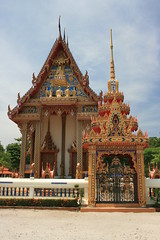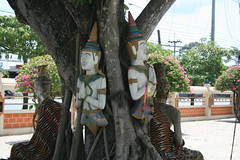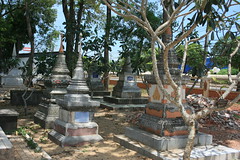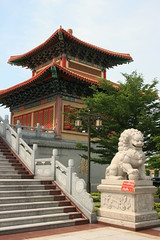 A daytrip from Bangkok I have done three times already is the market at Don Wai, close to Phutthamonthon in Nakhon Pathom province. It is a huge market where almost everything is sold - from fresh fruits, herbs, dried and fresh fish, up to all the different kinds of sweet snacks. But also toys, Buddha statues, even plants are on sale there. And of course there are several restaurants. Especially for Thais this market is already the prime attraction, yet what I enjoy most there are the boat trips on Tha Chin river.
A daytrip from Bangkok I have done three times already is the market at Don Wai, close to Phutthamonthon in Nakhon Pathom province. It is a huge market where almost everything is sold - from fresh fruits, herbs, dried and fresh fish, up to all the different kinds of sweet snacks. But also toys, Buddha statues, even plants are on sale there. And of course there are several restaurants. Especially for Thais this market is already the prime attraction, yet what I enjoy most there are the boat trips on Tha Chin river. Since on our latest visit there I had my GPS tracker with me, I could make a map showing the exact way the boat took - from the pier at Don Wai till the bridge at Wat Rai Khing in Tha Talat, and back. At the turning point it had the standard activity of Thai at water bodies - feeding the fish with bread. Also a small boat with a ice-cream dealer docked to sell a snack.
Since on our latest visit there I had my GPS tracker with me, I could make a map showing the exact way the boat took - from the pier at Don Wai till the bridge at Wat Rai Khing in Tha Talat, and back. At the turning point it had the standard activity of Thai at water bodies - feeding the fish with bread. Also a small boat with a ice-cream dealer docked to sell a snack.View Larger Map
From the river one can see all different types of housing, from very plain houses up to villas, mostly on the western shore. On the east shore it has two temples, Wat Rai Khing at the turning point and Wat Tha Phut a bit upriver. But what makes the trip most enjoyable is that we always bought many things to eat before and brought them on the boat - in the first trip, which was at my first trip to Thailand, I even had a complete lunch on the boat.
 Though it is mostly used as the parking lot of the market, the temple Wat Don Wai is also worth a short visit. I don't know why, but the photos of that temple looked almost artificial in their colors, and I did nothing like HDR with them.
Though it is mostly used as the parking lot of the market, the temple Wat Don Wai is also worth a short visit. I don't know why, but the photos of that temple looked almost artificial in their colors, and I did nothing like HDR with them.For the full set of photos see the Don Wai set at flickr.
















































